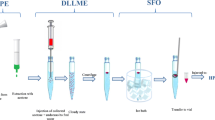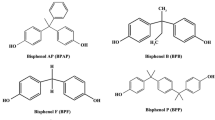Abstract
Monitoring of bisphenols (BPs) in feed is a necessary process for the security of food of animal origin. In this study, a method was established to simultaneously detect bisphenol A (BPA), bisphenol B (BPB), bisphenol C (BPC), bisphenol E (BPE), bisphenol F (BPF), bisphenol AP (BPAP), bisphenol Z (BPZ), bisphenol P (BPP) and bisphenol PH (BPPH) in feed. A simple and rapid pretreatment procedure was developed using ultrasound-assisted extraction (UAE) and dispersive solid-phase extraction (DSPE), and then the prepared sample was analysed by high-performance liquid chromatographic (HPLC) with fluorescence detector (FLD). Finally, the operating conditions of UAE, DSPE, and HPLC were all optimised to increase the sample throughput and sensitivity. Under the optimized conditions, good linearities were obtained for nine BPs with the correlation coefficients (R2) above 0.995; the recoveries of nine BPs in spiked feed samples were in the range of 82.56–103.87% and relative standard deviations (RSDs) were in the range of 2.4–13.40%; the limits of detections (LODs) and quantitations (LOQs) were in the range of 1.0–5.0 and 3.3–16.6 μg kg − 1, respectively. The results clearly demonstrated the developed method provided the reliable screening and quantification of nine BPs in feed and possessed the advantages including low cost, quick, and simple.
Graphic abstract






Similar content being viewed by others
References
Wang LY, Ding GD, Zhou ZG, Liu X, Wang YX, Xie HQ, Xu T, Wang P, Zhao B (2017) Level and characteristics of polychlorinated dibenzo-p-dioxins and dibenzofurans in feed and feed additives. J Environ Sci 51:324–331
Hamilton DJ (2018) A data-fitted mathematical sequence to calculate depuration rates for pesticide residues in milk from dairy cow feeding studies. Comput Toxicol 6:1–8
Gerald REF, Wilks MF (2014) Bisphenol A-why an adverse outcome path way frame work needs to be applied. Toxicol Lett 230:368–374
Kitamura S, Suzuki T, Sanoh S, Kohta R, Jinno N, Sugihara K, Yoshihara S, Fujimoto N, Watanabe H (2005) Comparative study of the endocrine-disrupting activity of bisphenol A and 19 related compounds. Toxical Sci 84:249–259
Atkinson A, Roy D (1995) In vivo DNA adduct formation by bisphenol A. Environ Mol Mutagen 26:60–66
Molina A, Abril N, Morales-Prieto N, Monterde J, Ayala N, Loraa A, Moyano R (2018) Hypothalamic-pituitary-ovarian axis perturbation in the basis of bisphenol A (BPA) reproductive toxicity in female zebrafish (Danio rerio). Ecotox Environ Safe 156:116–124
Saal FSV, Cooke PS, Buchanan DL, Palanza P, Thayer KA, Nagel SC, Parmigiani S, Welshons WV (1998) A physiologically based approach to the study of bisphenol A and other estrogenic chemicals on the size of reproductive organs, daily sperm production, and behavior. Toxicol Ind Health 14(1–2):239–260
Wang IJ, Chen CY, Bornehagea CG (2016) Bisphenol A exposure may increase the risk of development of atopic disorders in children. Int J Hyg Envir Heal 219:311–316
Jalal N, Surendranath AR, Pathak JL, Yu S, Chung CY (2018) Bisphenol A (BPA) the mighty and the mutagenic. Toxicol Rep 5:76–84
Fattore M, Russo G, Barbato F, Grumetto L, Albrizio S (2015) Monitoring of bisphenols in canned tuna from Italian markets. Food Chem Toxicol 83:68–75
Castro DR, Arcos GP, Cuartas AT, Del BPF (2003) Preparation for response to an industrial disaster in Spain. Pub Heal 117(4):260–261
Regueiro J, Wenzl T (2015) Determination of bisphenols in beverages by mixed-modesolid-phase extraction and liquid chromatography coupled to tandemmass spectrometry. J Chromatogra A 1422:230–238
Liu SH, Xie QL, Chen J, Sun JZ, He H, Zhang XK (2013) Development and comparison of two dispersive liquid–liquid microextraction techniques coupled to high performance liquid chromatography for the rapid analysis of bisphenol A in edible oils. J Chromatogra A 1295:16–23
Usman A, Ahmad M (2018) From BPA to its analogues: is it a safe journey? Chemosphere 158:131–142
Švajger U, Dolenc MS, Jeras M (2016) In vitro impact of bisphenols BPA, BPF, BPAF and 17 β-estradiol (E2) on human monocyte-derived dendritic cell generation, maturation and function. Int Immunopharmaco 34:146–154
Ullah A, Pirzada M, Jahan S, Ullah H, Shaheen G, Rehman H, Siddiqui MF, Butt MA (2018) Bisphenol A and its analogs bisphenol B, bisphenol F, and bisphenol S: comparative in vitro and in vivo studies on the sperms and testicular tissues of rats. Chemosphere 209:508–516
Lorber M, Schecter A, Paepke O, Shropshire W, Christensen K, Birnbaum L (2015) Exposure assessment of adult intake of bisphenol A (BPA) with emphasis on canned food dietary exposures. Environ Int 77:55–62
Vitku J, Chlupacova T, Sosvorova L, Hampl R, Hill M, Heracek J, Bicikova M, Starka L (2015) Development and validation of LC–MS/MS method for quantification of bisphenol A and estrogens in human plasma and seminal fluid. Talanta 140:62–67
Heffernan AL, Thompson K, Eaglesham G, Vijayasarathy S, Mueller JF, Sly PD, Gomez MJ (2016) Rapid, automated online SPE-LC-QTRAP-MS/MS method for the simultaneous analysis of 14 phthalate metabolites an 5 bisphenol analogues in human urine. Talanta 151:224–233
Zimmers SM, Browne EP, O’Keefe PW, Anderton DL, Kramer L, Reckhow DA, Arcaro KE (2014) Determination of free Bisphenol A (BPA) concentrations in breast milk of U.S. women using a sensitive LC/MS/MS method. Chemosphere 104:237–243
Olmo MD, Gonzlez-Casado A, Navas NA, Vilchez JL (1997) Determination of bisphenol A (BPA) in water by gas chromatography-mass spectrometry. Anal Chim Acta 346:87–92
Mei ZL, Qu W, Deng Y, Chu HQ, Cao JX, Xue F, Zheng L, El-Nezamic HS, Wu YC, Chen W (2013) One-step signal amplified lateral flows trip biosensor for ultrasensitive and on-site detection of bisphenol A (BPA) in aqueous samples. Biosens Bioelectron 49:457–461
Messaoud NB, Ghica ME, Dridi C, Alia MB, Brett CMA (2018) A novel amperometric enzyme inhibition biosensor based on xanthine oxidase immobilised onto glassy carbon electrodes for bisphenol A determination. Talanta 184:388–393
Gallo P, Pisciottano IDM, Esposito F, Fasano E, Scognamiglio G, Mita GD, Cirillo T (2017) Determination of BPA, BPB, BPF, BADGE and BFDGE in canned energy drinks by molecularly imprinted polymer cleaning up and UPLC with fluorescence detection. Food Chem 220:406–412
Anastassiades M, Lehotay SJ (2003) Fast and easy multiresidue method mmploying acetonitrile extraction/partitioning and “dispersive solid-phase extraction” for the determination of pesticide residues in produce. J AOAC Int 86:412–431
Yilmaz E, Alothman ZA, Sumayli HMT, Brahim E, Soylak M (2012) Sorbent extraction of Pb(II), Cu(II), Ni(II), and Fe(III) Ions as 2-(5-Bromo-2-Pyridylazo)-5-diethylamino-phenol chelates on single-walled carbon nanotube disks prior to their flame atomic absorption spectrometric determinations in animal feeds and natural water samples. J AOAC Int 95(4):1205–1210
Alfaris NA, Wabaidur SM, Alothman ZA, AltamimiJZ ATS (2020) Fast and efficient immunoaffinity column cleanup and liquid chromatography–tandem mass spectrometry method for the quantitative analysis of aflatoxins in baby food and feeds. J Sep Sci 43:2079–2087
Muñoz-Solano B, González-Peñas E (2020) Mycotoxin determination in animal deed: an LC-FLD method for simultaneous quantification of aflatoxins, ochratoxins and zearelanone in this matrix. Toxins (Basel) 12(6):374
Kumar A, Bhattacharyya A, Shinde R, Dhanshetty M, Elliott CT, Banerjee K (2020) Development and validation of a multiresidue method for pesticides and selected veterinary drugs in animal feed using liquid- and gas chromatography with tandem mass spectrometry. J Chromatogr A 1627:461416
Song XQ, Huang QW, Zhang YX, Zhang MY, Xie JM, He LM (2019) Rapid multiresidue analysis of authorized/banned cyclopolypeptide antibiotics in feed by liquid chromatography-tandem mass spectrometry based on dispersive solid-phase extraction. J Pharm Biomed Anal 170:234–242
Liu YY, Hu XL, Bao YF, Yin DQ (2018) Simultaneous determination of 29 pharmaceuticals in fish muscle and plasma by ultrasonic extraction followed by SPE–UHPLC–MS/MS. J Sep Sci 41:2139–2150
Salima ZA, Mostapha B, Belma ZK, Fatih S, Hayette L (2019) Optimization of ultrasound-assisted extraction of total phenolic contents and antioxidant activity using response surface methodology from jujube leaves (Ziziphus jujuba) and evaluation of anticholinesterase inhibitory activity. J Food Meas Charact 13:321–329
Habila M, Yilmaz E, Alothman ZA, Soylak M (2016) Combination of dispersive liquid–liquid microextraction and multivariate optimization for separation-enrichment of traces lead by flame atomic absorption spectrometry. J Ind Eng Chem 37:306–311
Habila MA, Alothman ZA, Yilmaz E, Soylak M (2018) Dispersive liquid-liquid microextraction of lead (II) as tropaeolin OOO chelates from environmental samples prior to microsampling flame atomic absorption spectrometry. Atom Spectrosc 39(3):112–117
Othman ZA, Unsal YE, Habila M, Shabaka A, Tuzen M, Soylak M (2015) Determination of copper in food and water by dispersive liquid-liquid microextraction and flame atomic absorption spectrometry. Anal Lett 48:1738–1750
Habila MA, Alothman ZA, Soylak M (2015) Use of Fe3O4 nanoparticles and ultrasound-assisted dispersive liquid-liquid microextraction of lead in water, tobacco, and fertilizer samples for FAAS determination. Atom Spectrosc 36(3):146–151
Rocha BA, Costa BRBD, Albuquerque NCPD, Oliveira ARMD, Souza JMO, Al-Tameemi M, CampigliaFB AD Jr (2016) A fast method for bisphenol A and six analogues (S, F, Z, P, AF, AP) determination in urine samples based on dispersive liquid-liquid microextraction and liquid chromatography-tandem mass spectrometry. Talanta 154:511–519
Magda Caban M, Piotr Stepnowski P (2020) The quantification of bisphenols and their analogues in wastewaters and surface water by an improved solid-phase extraction gas chromatography/mass spectrometry method. Environ Sci Pollut R 27:28829–28839
García-Córcoles MT, Cipa M, Rodríguez-Gómez R, Rivas A, Olea-Serrano F, Vílchez JL, Zafra-Gómez A (2018) Determination of bisphenols with estrogenic activity in plastic packaged baby food samples using solid–liquid extraction and clean-up with dispersive sorbents followed by gas chromatography tandem mass spectrometry analysis. Talanta 178:441–444
Yao QH, Feng YF, Tan C, Xia SJ, Zhao L, Wang SY, Wang YR, Chen X (2018) An on-line solid-phase extraction disc packed with a phytic acid induced 3D graphene-based foam for the sensitive HPLC-PDA determination of bisphenol A migration in disposable syringes. Talanta 179:153–161
Acknowledgments
This research was funded by research grants from the innovation project of Chinese Academy of Agricultural Sciences (CAAS-ASTIP-2014-LIHPS-01) and the project of modern industry technology system of beef and yak (CARS-37). The authors are grateful to the Ministry of Agriculture of the People’s Republic of China for the financial support.
Author information
Authors and Affiliations
Corresponding author
Ethics declarations
Conflict of interest
The authors declare no conflict of interest.
Ethical approval
No animals or humans or biological fluids were used to generate the data presented.
Additional information
Publisher's Note
Springer Nature remains neutral with regard to jurisdictional claims in published maps and institutional affiliations.
Rights and permissions
About this article
Cite this article
Xiong, L., Pei, J., Wu, X. et al. Multi-residue Determination of Bisphenol Compounds in Feed Using Ultrasound-Assisted Extraction and Dispersive Solid-Phase Extract Followed by High-Performance Liquid Chromatography with Fluorescence Detector. Chromatographia 83, 1423–1433 (2020). https://doi.org/10.1007/s10337-020-03955-3
Received:
Revised:
Accepted:
Published:
Issue Date:
DOI: https://doi.org/10.1007/s10337-020-03955-3




